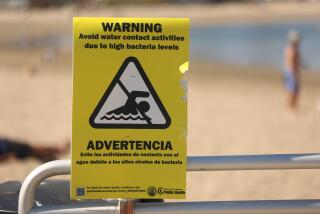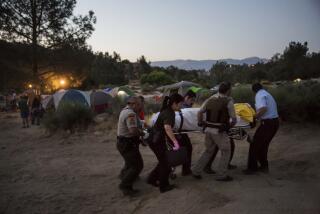Consumers : Eliminating the Dangers of Back-Yard Pools
- Share via
Hauling out the patio chairs, cranking up the barbecue and getting the swimming pool ready for summer? Remember, the same pool that provides your family with refreshing dips on hot days also can be a back-yard danger for children if you haven’t followed safety procedures.
“A swimming pool is a tremendous risk for a child--it’s a silent accident, a silent issue,” said Billie Weiss, of the Los Angeles County Health Department, who has been working on a study of drownings and near-drownings in the county.
Small children--under age 5--are most at risk for swimming pool accidents and should be under constant supervision. When it comes to safety, nothing, of course, quite matches supervision of swimmers, whatever their age.
But owners also should put up proper barriers to make pool areas safer. And though there’s no way to totally child-proof a pool or spa, health professionals and consumer safety advocates recommend that you:
--Ensure there’s proper fencing, at least 4-feet high, preferably 5-feet high, on all sides of the pool. Don’t forget to see that there is only a 2-inch clearance between the bottom of the fence and the ground and that no vertical opening in the fence is more than 4 inches wide. With chain link fences, be sure the diamond-shaped openings are 1x1-inch so children cannot get a toehold and climb over the fence. And be sure that the fence permits a clear view of the pool from your house.
--Secure all fences with self-closing access gates and self-latching devices at least 56 inches from the ground.
--Keep all doors leading from house to pool locked routinely; install locks on those doors at least 5 feet above the floor.
--Remove that cover completely when the pool is in use. Swimmers, young or old, can get trapped under a partially extended cover, as the U.S. Consumer Product Safety Commission has often warned in alerts it has issued to owners of solar pool covers.
--Put away access steps if you have an above-ground pool and it is not in use.
In case an accident does occur, be sure you have proper lifesaving equipment--such as a pole or ring--at poolside; be sure, too, that someone in your household knows first aid techniques like CPR or mouth-to-mouth resuscitation. It’s also a good idea to keep a telephone on or near your patio with emergency numbers listed next to it.
Last year, 350 children under age 5 drowned in swimming pools nationwide; another 4,000 youngsters had to be hospitalized after near-drownings, according to the National Spa and Pool Institute in Alexandria, Va.
Yearly Increases
Records show the national total of drownings and near-drownings of children under age 5 has increased every year since the mid-1980s. And California is no exception. In 1985, 103 Calfornia children drowned in pools and spas; in 1986, there were 123 fatalities; in 1987, there were 140. State statistics are not yet available for 1988.
But in Los Angeles County alone in 1988, there were 95 pool-related deaths, 23 of them involving children 4-years-old and younger.
The Los Angeles County Health Department study that Weiss has been working on shows that from June, 1988, to May, 1989, among all age groups there were 226 water-injury-related reports--38 of them fatalities, 188 near-drownings. Of the 226 incidents, almost 80% of the instances were in swimming pools; 118 of them involved children up to age 4.
“In Los Angeles County, the leading cause of death between ages 1 and 4 is drowning,” Weiss said. “Children this age in California have a higher risk of drowning in a pool than dying in an auto accident.”
In Orange County, where one child drowned and two others suffered brain-damage after falling in a swimming pool at a North Tustin home on March 30, recent statistics also are chilling. There were 15 emergency medical service calls (EMS) in March just for near-drownings involving children under age 5, said Dollie Brill of Newport Beach, president of the National Drowning Prevention Network, which has memberships in 48 states.
15 Injuries Per 100,000
“There are 100,000 residential swimming pools in Orange County--and that’s substantially underestimated. With 15 EMS calls, then that’s an injury rate of 15 per 100,000,” Brill said during a telephone interview. “If that was any other product, mayonnaise, for instance, it would be banned from the market.”
Brill--who co-chairs Protect Our Kids, a drowning prevention program for children run by the Orange County Trauma Society--is closer to the pool safety issue than many who study it. Her daughter, Cassy, then 15 months old, was the victim of a pool accident a decade ago.
“She spent 36 hours unconscious and unresponsive, then she woke up,” Brill recalled. “We were very, very lucky. She’s fine, is a gifted student and an excellent athlete.
“But,” she added, “so many of those children who nearly drown end up brain-damaged.” With improved emergency medical response, “we’re decreasing the fatalities, but ending up with more brain-damaged children; 1 out of 5 ends up with brain damage.”
It’s hard to get an accurate count of the number of residential swimming pools in the United States but the spa and pool institute estimates there are 6.5 million residential pools and spas in the nation’s back yards. California industry analysts estimate that there are about 300,000 swimming pools in Los Angeles and Orange counties alone.
No National Codes
There are no national codes calling for barriers around swimming pools and spas. Those codes mostly are left to states and municipalities. Los Angeles city and county, and Orange County, have pool fencing codes. The consumer safety commission is working on a proposal for a residential pool barrier code and hopes that state and local governments, building code groups and consumers will adopt its recommendations nationwide.
“The use of effective residential swimming pool barriers is believed to be one of the very best ways available at this time to reduce deaths and serious injuries sustained by children under 5,” the commission has reported. “A barrier is vital to the safety of children since parents cannot be expected to keep children in their line of sight 100% of the time.”
Commission researchers report that “the typical child drowning victim is a boy between 1 and 3 years of age who is not thought by parents and caretakers to be in the pool or spa area . . . In the time it takes to answer a phone call, the child, if left alone, could be in great danger.” National safety statistics also show that 65% of the drownings and near drownings of small children happen in a pool owned by the child’s family.
Some safety experts suggest a pool alarm can give added protection against a pool accident but they stress that any such device should be used in addition to proper barriers. Pool alarms on the market now range in price from $115 to $300.
But the safety commission, which tested four popular brands of alarms in 1987, decided not to recommend any of them to pool owners, commenting that the devices, “although they generally performed in accordance with the manufacturers’ literature” had “significant problems with false alarms and/or failure to alarm” during tests. “For this reason, the commission staff does not consider the existing devices as capable of providing completely reliable warnings.”
The report added that “users of pool alarms need to be aware of the limitations of the devices so that they are not overly relied upon for safety.”
SWIMMING POOL DROWNINGS 1987 figures, listed by county: Los Angeles: 150 San Diego: 47 Riverside: 25 Orange: 20 SOURCE: State Department of Health Services, Health Demographics Section
CONSUMER VIEWS
Sweepstakes “telescam.” Page 10.
NEW AND USEFUL
A sharper look at things. Page 10.
More to Read
Inside the business of entertainment
The Wide Shot brings you news, analysis and insights on everything from streaming wars to production — and what it all means for the future.
You may occasionally receive promotional content from the Los Angeles Times.










